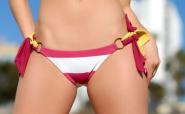Advertisement
Featured article
Laser, light and heat hair removal methods
A look at alternatives to electrolysis and waxing

Laser, light and heat hair removal are still relatively new treatments for most of us, although it is now easier than before to find salons and clinics that offer these procedures. Compared to the usual beauty treatments, opting for hair removal by one of these methods involves large expenditure, and in some cases requires financial assistance. If you’ve considered this type of hair removal but were afraid to ask, here is some basic but essential information which could help you decide.
Laser and Intense Pulsed Light (IPL)
Laser and light (‘Intense Pulsed Light’ or IPL) deliver light energy. This is absorbed into the hair where it reacts with the pigment; the hair becomes hot, then the heat is conducted into the follicle where it damages or disables the cells responsible for hair growth. Light coloured hair contains less pigment so may not absorb as much light as dark hair.
Skin type may also be a factor. Skin contains the pigment melanin; the darker the skin the more melanin it contains. If the the skin around the hair is darker than the hair itself it could absorb too much heat from the laser and this could lead to hyperpigmentation or dark marks.
article continuedAdvertisement
With most machines, in-salon air conditioning or an integrated cooling system is needed for client comfort. Manufacturers use the Fitzpatrick system of skin classification of 1 to VI, where 1 is pale, white skin and VI is dark brown to black. Four years ago, if you had dark hair and pale skin, you were the ideal candidate for laser and IPL hair removal, but not if you were the pale hair and pale skin combination or even dark hair with dark skin. Thankfully, things have improved and many systems have ways round this, but you need to find out from the salon.
Light Heat Energy (LHE)
Light heat energy (LHE) differs from laser and IPL in that it delivers heat in such a way that no skin cooling system is required. Because it does not emit light energy that reacts with pigment, it can remove all colours of hair, including blonde, red, white and grey, and on all types of skin. Other than that, it works using the same principle as IPL, where heat is conducted down the hair into the follicle to disable the hair-producing cells. The heat energy from LHE systems is not as powerful as the light from laser and IPLs.
Those people with little or no pigment in the hair may be better suited to the LHE system, while those with lots of pigment could work better with laser and IPL. However improvements are being made all the time; for example, there are topical applications that can be used to get around having little or no pigment in the hair.
The effects
The advantage of all the systems is that just about any facial or body hair can be treated. The average times for the treatments are: facial areas: 10-15 mins, underarm/bikini: less than 30 mins, back/legs/arms: up to 1 hour. At least 2 weeks prior to treatment, you must avoid plucking, waxing or bleaching hairs. Infected skin cannot be treated and you may have to avoid certain medication such as aspirin and ibuprofen.
Whatever system you go for, you must have a consultation first so the therapist can assess your hair and skin pigmentation and hair thickness, and estimate the price and duration of treatments. If it’s all too much for you, there’s always electrolysis and waxing!
Got something to say?
We are looking for authors! Submit an article.
Related articles
Not Born Blonde?
Tips on how to lighten your hair for non-blondes
Bad hair day FAQ
Hair emergencies - some questions and answers
Hair Care FAQs
Some common questions about hair care answered
Top Stories
Review: Dancing with the Stars - Cardio Dance
An aerobic alternative with the stars from TV
Eye shadow pigment - seven ways to make yourself beautiful
A bunch of ideas for this versatile makeup item
Home treatments for cellulite
What you can do at home to combat cellulite
Comments
Add your comment